Effect of Local Momentum Ratio on Spray Windward Distribution of a Gas–Liquid Pintle Injector Element
Abstract
:1. Introduction
2. Overview of Spray Experiments
2.1. Test and Measurement System
2.2. Operating Conditions of a Gas–Liquid Pintle Injector Element
2.3. Discharge Coefficient
3. Results and Discussion
3.1. Extraction of the Windward Boundary Band
3.2. Effect of Parameter on the Windward Boundary Band
3.3. Empirical Model
4. Conclusions
Author Contributions
Funding
Institutional Review Board Statement
Informed Consent Statement
Data Availability Statement
Conflicts of Interest
Nomenclature
| A | Throttling area of injection channel |
| Cd | Discharge coefficient |
| d | Circular-orifice diameter |
| gi | Grayscale value |
| h | Rectangular-slit height |
| k | Specific heat ratio |
| L | Pintle length |
| LMR | Local momentum ratio |
| Ls | Skip distance |
| n | Sample number |
| Pe | Outlet pressure of injection channel |
| Pi | Inlet pressure of injection channel |
| ΔP | Injection pressure drop |
| q | Mass flow rate |
| R | Gas constant of air, 287.041 J/(kg·K) |
| T | Fluid temperature |
| t | Total test time-length |
| tspray | Time-length of a certain spatial location occupied by water jet/spray |
| v | Injection velocity |
| w | Rectangular-slit width |
| ρ | Fluid density |
| γ | Spray fraction |
| θ | Spray half angle |
| Subscribe | |
| G | Air |
| L | Water |
References
- Wei, X.; Feng, Y.; Ye, J.; Li, N.; Haidn, O.J. Influence of mass flow rate on the atomization characteristics of screw conveyor swirl injectors. Aerospace 2022, 9, 293. [Google Scholar] [CrossRef]
- Zhou, C.; Zou, J.; Zhang, Y. Effect of streamwise perturbation frequency on formation mechanism of ligament and droplet in liquid circular jet. Aerospace 2022, 9, 191. [Google Scholar] [CrossRef]
- Dressler, G.A.; Bauer, J.M. TRW pintle engine heritage and performance characteristics. In Proceedings of the 36th AIAA/ASME/SAE/ASEE Joint Propulsion Conference & Exhibit, Las Vegas, NV, USA, 24–28 July 2000; Available online: https://arc.aiaa.org/doi/10.2514/6.2000-3871 (accessed on 15 July 2022).
- Dressler, G.A. Summary of deep throttling rocket engines with emphasis on Apollo LMDE. In Proceedings of the 42nd AIAA/ASME/SAE/ASEE Joint Propulsion Conference & Exhibit, Sacramento, CA, USA, 9–12 July 2006; Available online: https://arc.aiaa.org/doi/abs/10.2514/6.2006-5220 (accessed on 15 July 2022).
- Casiano, M.J.; Hulka, J.R.; Yang, V. Liquid-propellant rocket engine throttling: A comprehensive review. J. Propuls. Power 2010, 26, 897–923. [Google Scholar] [CrossRef]
- Betts, E.M.; Frederick, R.A. A historical systems study of liquid rocket engine throttling capabilities. In Proceedings of the 46th AIAA/ASME/SAE/ASEE Joint Propulsion Conference & Exhibit, Nashville, TN, USA, 25–28 July 2010; Available online: https://arc.aiaa.org/doi/abs/10.2514/6.2010-6541 (accessed on 15 July 2022).
- Sun, Z.; Jia, Y.; Zhang, H. Technological advancements and promotion roles of Chang’e-3 lunar probe mission. Sci. China Ser. E Technol. Sci. 2013, 56, 2702–2708. [Google Scholar] [CrossRef]
- Yue, C.G.; Li, J.X.; Hou, X.; Feng, X.P.; Yang, S.J. Summarization on variable liquid thrust rocket engines. China Ser. E Technol. Sci. 2009, 52, 2918–2923. [Google Scholar] [CrossRef]
- Heister, S.D. Handbook of Atomization and Sprays: Theory and Applications; Springer Science & Business Media: New York, NY, USA, 2011. [Google Scholar]
- Sakaki, K.; Funahashi, T.; Nakaya, S.; Tsue, M.; Kanai, R.; Suzuki, K.; Inagawa, T.; Hiraiwa, T. Longitudinal combustion instability of a pintle injector for a liquid rocket engine combustor. Combust. Flame 2018, 194, 115–127. [Google Scholar] [CrossRef]
- Cheng, P. The Dynamics of Spray Combustion in Variable Thrust Rocket Engines. Ph.D. Thesis, Graduate School of National University of Defense Technology, Changsha, China, 2018. [Google Scholar]
- Jin, X.; Shen, C.; Zhou, R.; Fang, X. Effects of LOX particle diameter on combustion characteristics of a gas-liquid pintle rocket engine. Int. J. Aerosp. Eng. 2020, 2020, 8867199. [Google Scholar] [CrossRef]
- Son, M.; Radhakrishnan, K.; Koo, J.; Kwon, O.C.; Kim, H.D. Design procedure of a movable pintle injector for liquid rocket engines. J. Propuls. Power 2017, 33, 858–869. [Google Scholar]
- Radhakrishnan, K.; Son, M.; Lee, K.; Koo, J. Effect of injection conditions on mixing performance of pintle injector for liquid rocket engines. Acta Astronaut. 2018, 150, 105–116. [Google Scholar] [CrossRef]
- Lee, K.; Shin, D.; Son, M.; Moon, H.; Koo, J. Flow visualization of cryogenic spray from a movable pintle injector. J. Vis. 2019, 22, 773–781. [Google Scholar] [CrossRef]
- Lee, S.; Koo, J.; Yoon, Y. Effects of skip distance on the spray characteristics of a pintle injector. Acta Astronaut. 2021, 178, 471–480. [Google Scholar] [CrossRef]
- Zhang, Y.; Yu, N.; Tian, H.; Li, W.; Feng, H. Experimental and numerical investigations on flow field characteristics of pintle injector. Aerosp. Sci. Technol. 2020, 103, 105924. [Google Scholar] [CrossRef]
- Zhou, W.; Xu, X.; Yang, Q.; Zhao, R.; Jin, Y. Experimental and numerical investigations on the spray characteristics of liquid-gas pintle injector. Aerosp. Sci. Technol. 2022, 121, 107354. [Google Scholar] [CrossRef]
- Jin, X.; Bing, C. Fragmentation and atomization characteristics of near-orifice liquid jet under transverse gas film. Acta Phys. Sin. 2022, 71, 114701. [Google Scholar] [CrossRef]
- Jin, X.; Bing, C.; Lin, S.; Zhou, R. Experimental study on the spray characteristics of a gas-liquid pintle injector element. J. Vis. 2022, 25, 467–481. [Google Scholar] [CrossRef]
- Tharakan, T.J.; Rafeeque, T.A. The role of backpressure on discharge coefficient of sharp edged injection orifices. Aero. Sci. Technol. 2016, 49, 269–275. [Google Scholar] [CrossRef]
- Yu, B.; Fu, P.; Zhang, T.; Zhou, H. The influence of back pressure on the flow discharge coefficients of plain orifice nozzle. Int. J. Heat Fluid Flow 2013, 44, 509–514. [Google Scholar] [CrossRef]
- Wu, L.; Wang, Z.; Li, Q.; Li, C. Unsteady oscillation distribution mo del of liquid jet in sup ersonic crossflows. Acta Phys. Sin. 2016, 65, 094701. [Google Scholar]
- Otsu, N. A threshold selection method from gray-level histogram. IEEE Trans. Syst. Man Cybern. 1979, 9, 62–66. [Google Scholar] [CrossRef]
- Cheng, P.; Li, Q.; Xu, S.; Kang, Z. On the prediction of spray angle of liquid-liquid pintle injectors. Acta Astronaut. 2017, 138, 145–151. [Google Scholar] [CrossRef]

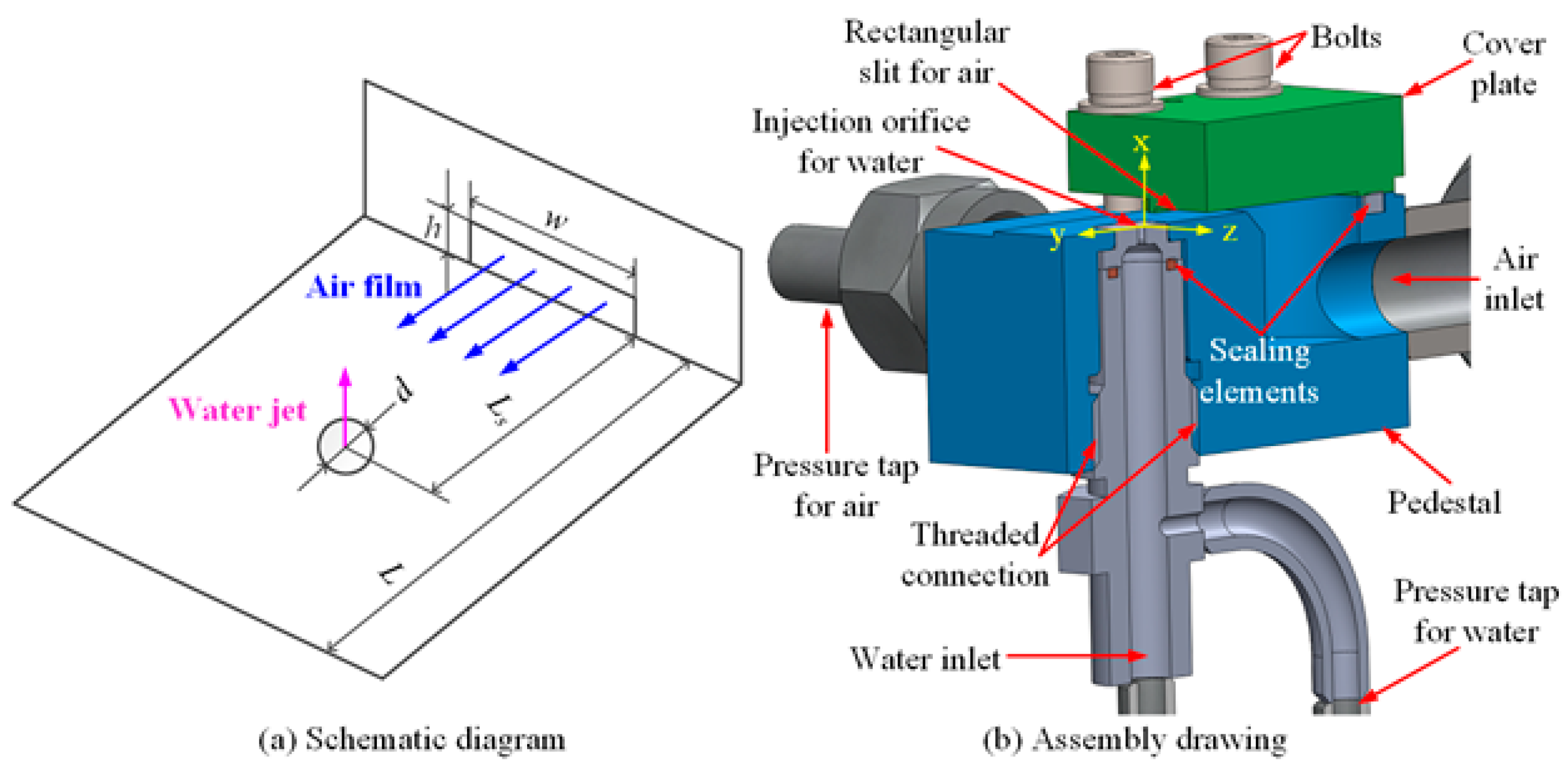
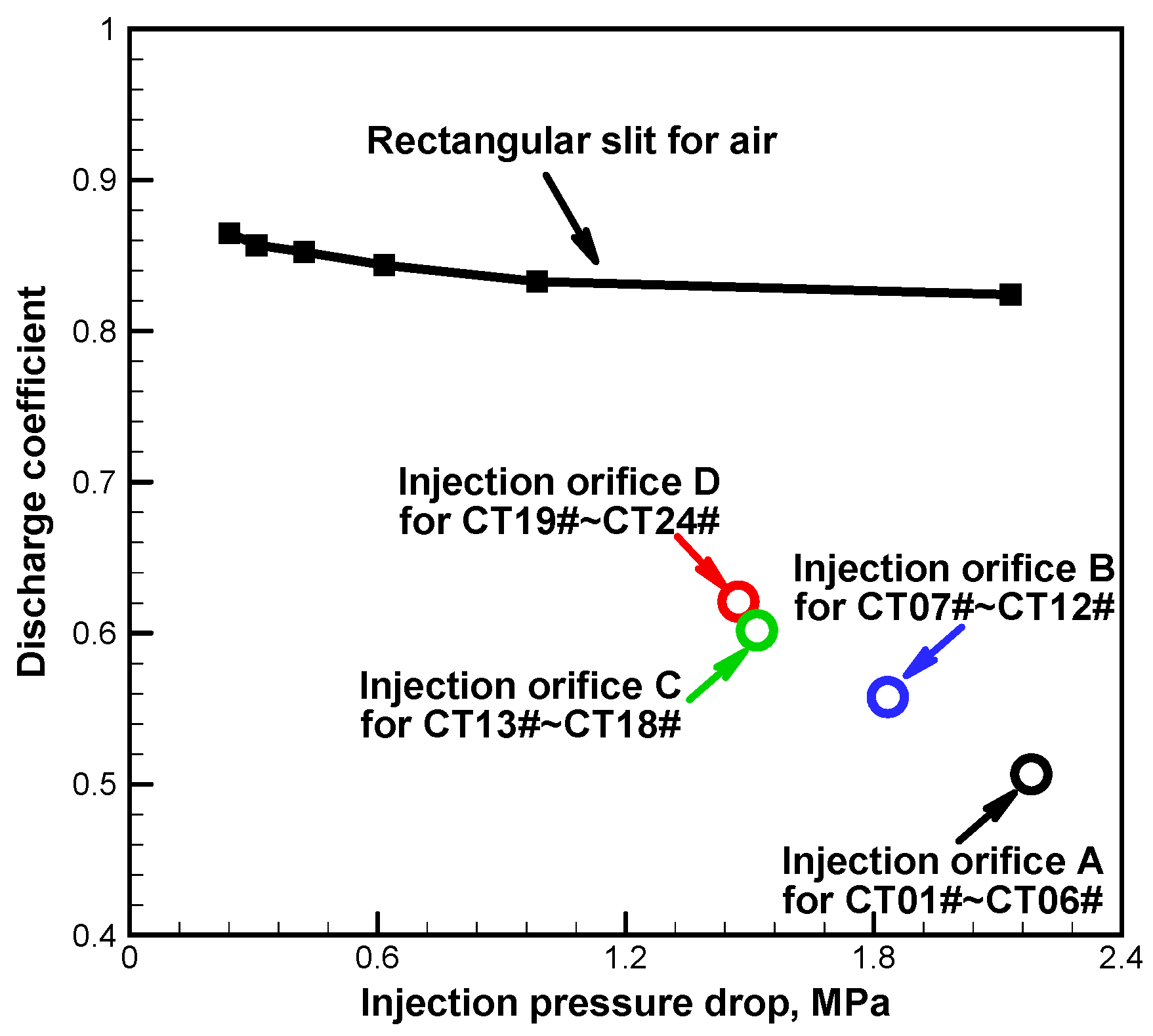
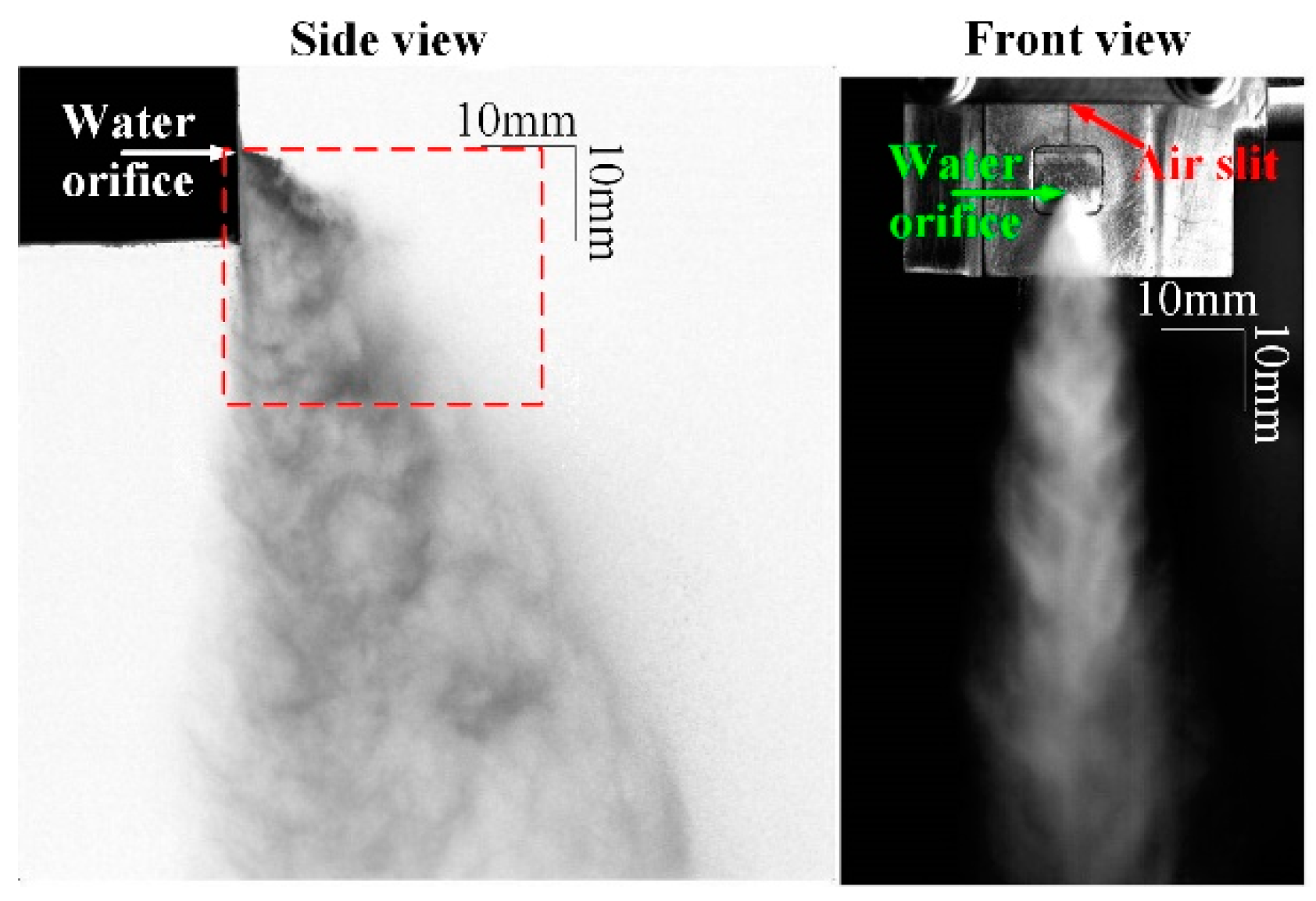


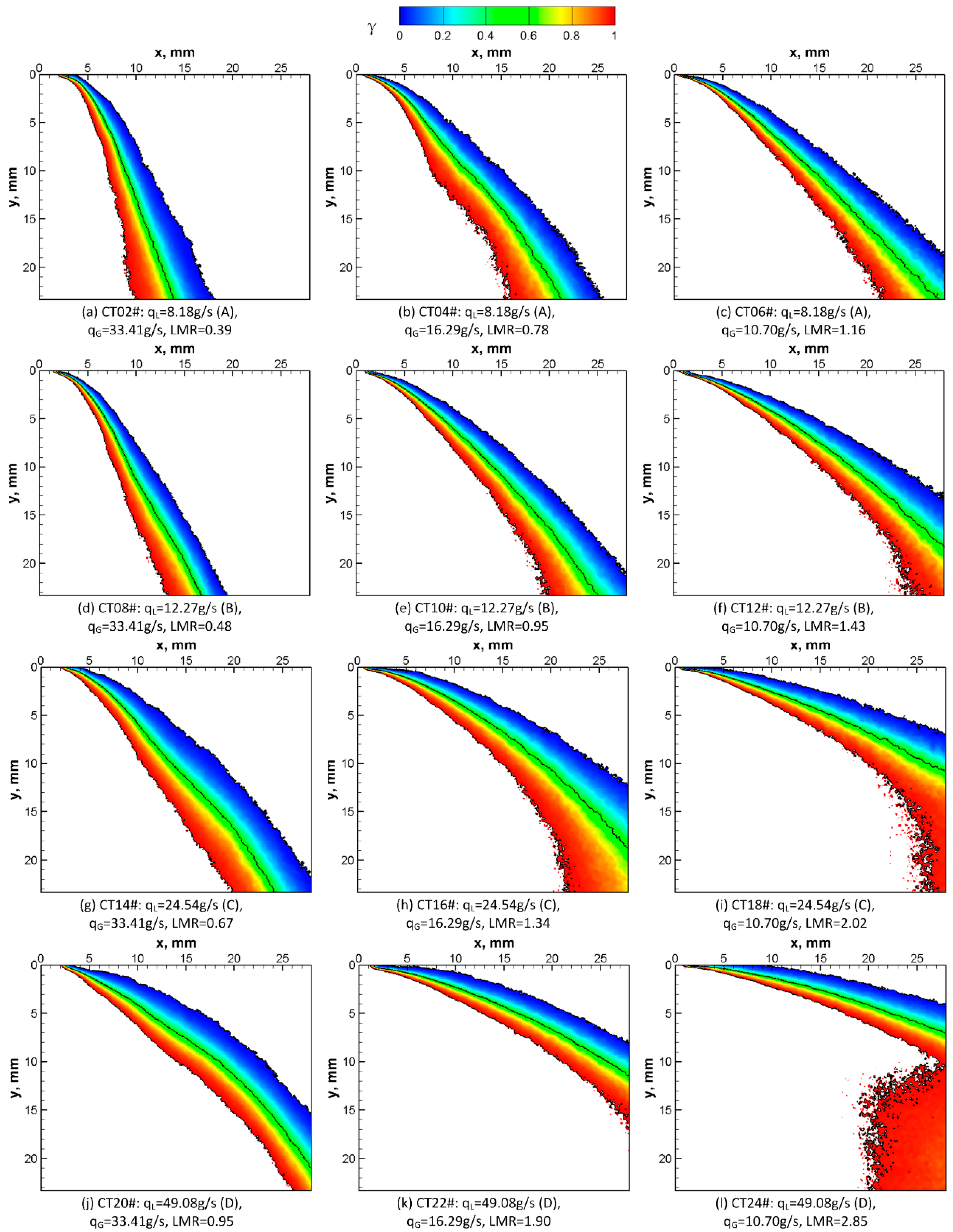

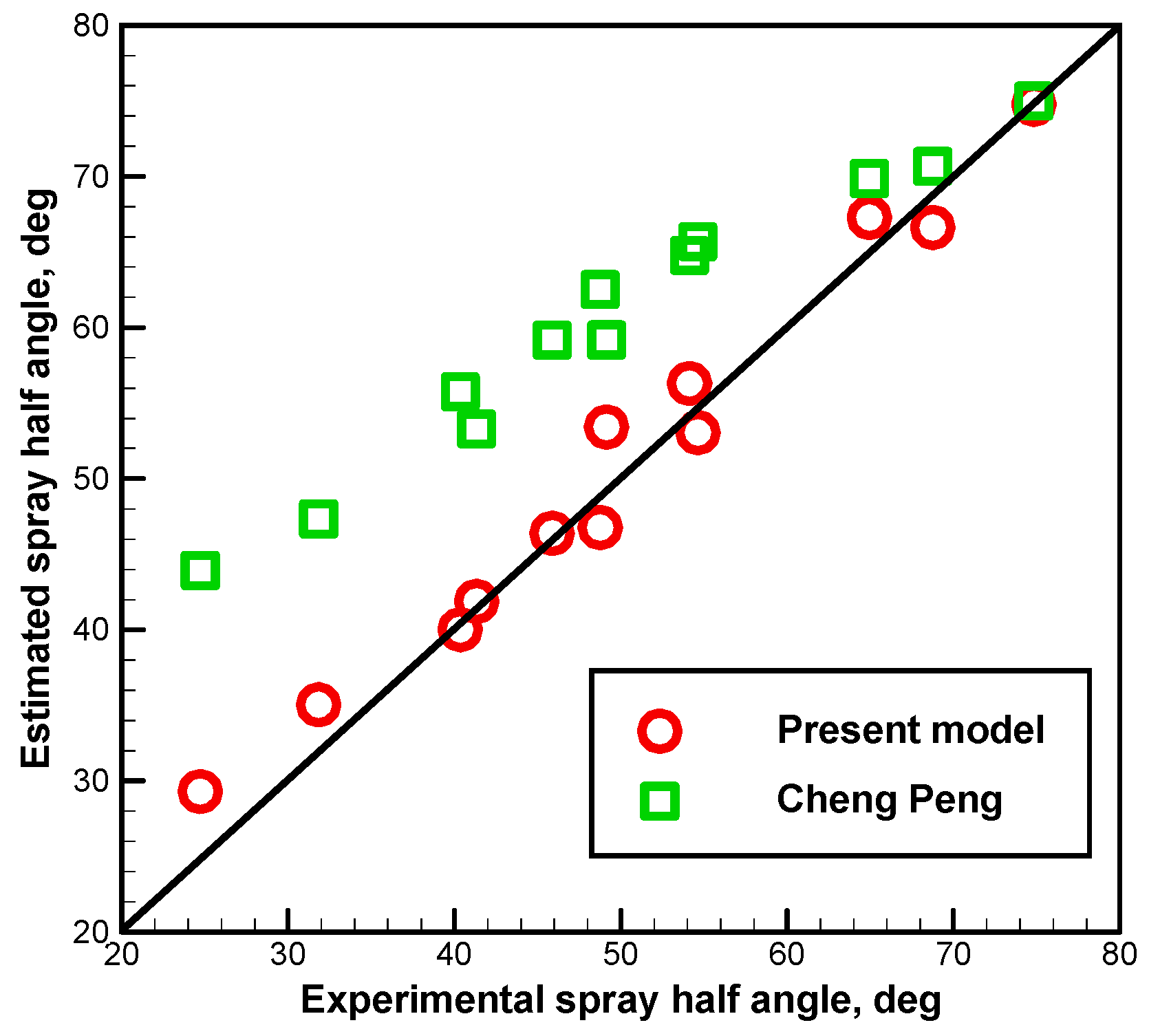
| Test No. | Injection Orifice and qL (g/s) | ||||
|---|---|---|---|---|---|
| A and 8.18 | B and 12.27 | C and 24.54 | D and 49.08 | ||
| qG (g/s) and vG (m/s) | 67.42 & 262.89 | CT01# | CT07# | CT13# | CT19# |
| 33.41 & 265.22 | CT02# | CT08# | CT14# | CT20# | |
| 21.95 & 269.01 | CT03# | CT09# | CT15# | CT21# | |
| 16.29 & 272.04 | CT04# | CT10# | CT16# | CT22# | |
| 12.98 & 273.06 | CT05# | CT11# | CT17# | CT23# | |
| 10.70 & 275.90 | CT06# | CT12# | CT18# | CT24# | |
Publisher’s Note: MDPI stays neutral with regard to jurisdictional claims in published maps and institutional affiliations. |
© 2022 by the authors. Licensee MDPI, Basel, Switzerland. This article is an open access article distributed under the terms and conditions of the Creative Commons Attribution (CC BY) license (https://creativecommons.org/licenses/by/4.0/).
Share and Cite
Jin, X.; Yang, Y.; Cao, X.; Wu, J. Effect of Local Momentum Ratio on Spray Windward Distribution of a Gas–Liquid Pintle Injector Element. Aerospace 2022, 9, 494. https://doi.org/10.3390/aerospace9090494
Jin X, Yang Y, Cao X, Wu J. Effect of Local Momentum Ratio on Spray Windward Distribution of a Gas–Liquid Pintle Injector Element. Aerospace. 2022; 9(9):494. https://doi.org/10.3390/aerospace9090494
Chicago/Turabian StyleJin, Xuan, Yang Yang, Xiaomei Cao, and Jinshui Wu. 2022. "Effect of Local Momentum Ratio on Spray Windward Distribution of a Gas–Liquid Pintle Injector Element" Aerospace 9, no. 9: 494. https://doi.org/10.3390/aerospace9090494
APA StyleJin, X., Yang, Y., Cao, X., & Wu, J. (2022). Effect of Local Momentum Ratio on Spray Windward Distribution of a Gas–Liquid Pintle Injector Element. Aerospace, 9(9), 494. https://doi.org/10.3390/aerospace9090494







